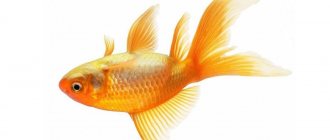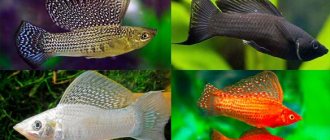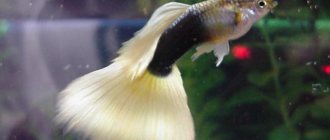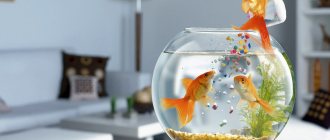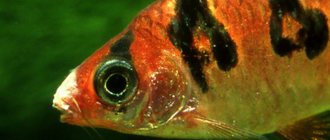Why did they fall down, lie on their belly or on their side?
If the fish lie on the bottom, then it is possible that the volume of the aquarium is too small for them. Also, the following circumstances may be the reasons for this behavior:
Overeating may be the reason that your pet suddenly finds itself at the bottom. The fish sinks down due to its heavy belly.- If you notice that the fish are at the bottom at night, this means that they are simply resting. All living creatures need rest, so most phenotypes sleep at night and are awake during the day.
- If the fish were recently put into a new tank, but they lay to the bottom, then the reason is adaptation.
- The fish was shocked. More often, osmotic shock attacks ornamental fish released into the aquarium without an acclimatization procedure. If the aquarium is properly adapted and meets the necessary requirements, then after two days the fish will get used to it and its behavior will become natural.
Change in water quality
Ammonia . Its presence is dangerous and toxic. The fish will not be able to breathe normally, which will lead to death. Attention: lethal level of ammonia is 0.2 - 1 mg/l.- Ammonium. It forms when water reacts with ammonia. It is dangerous for fish, although its toxicity is lower than that of ammonia.
- Nitrites and nitrates. They appear when ammonium oxidation occurs. Safe level of nitrates is 30 mg/l; lethal level of nitrates is 80-100 mg/l. The level of nitrites that causes stress is 0.5 ppm; Lethal nitrite level is 10-20 ppm.
If testing shows a deviation from the norm, then first of all you need to ensure an influx of clean water by making a partial replacement.
The scales fall off and fall off
Goldfish scales fall off as a result of:
Changing the temperature
If the fish lies on the bottom, this may be a sign of temperature shock, which occurs in most representatives of ornamental species when the temperature of the aquatic environment drops to +5°C and below. It is important to monitor temperature indicators, especially when introducing new individuals into the aquarium.
After the temperature increases, the fish will gradually come to its senses. However, subsequently, the stress experienced can negatively affect her health, provoking the development of infectious, autoimmune diseases, weakening of the immune system and the body’s own protective resources.
Fins have turned black
Darkening of fins is caused by:
Relocation
Many ornamental fish have an extremely difficult time moving to another artificial body of water. In such cases, passivity and lying on the bottom are manifestations of severe stress or even a state of shock. According to experts, the acclimatization stage falls into the normal category, and therefore there is no need to worry too much.
The main thing is to first study the characteristics of a particular type of fish, their requirements for the aquatic environment and take care of creating optimal conditions for keeping them.
As a rule, after a few days the fish gets used to the new habitat, its condition improves, and, consequently, the level of activity increases. If your pet spends more than 3-5 days in a lying position, while breathing heavily and showing other painful signs, you should seek advice from a specialist.
How to avoid problems
In order for the fish to feel comfortable and actively move around the aquarium without being in a lying position, it is important to create optimal, comfortable conditions for them. To do this, you should pay attention to the recommendations of experts regarding the arrangement of an artificial reservoir:
- Equipment. Most fish require additional lighting, filtration, and aeration. However, you should know how to properly use additional devices. When introducing new fish, it is recommended to include them a week after the completion of the acclimatization period.
- Soil – should be selected taking into account the characteristics and needs of a certain type of fish, which is planned to be populated.
- Pouring water should be done along the glass wall of the tank. After this, the water must sit for some time before fish can be introduced into it.
- Planting of aquatic and above-water green crops should be carried out several days after pouring water into an artificial reservoir.
- Timely cleaning of the tank and soil from food debris, waste products of aquarium inhabitants and other debris.
- Water replacement should be carried out weekly, approximately 25-30% of the total volume of liquid in the tank.
- Clean installed filters at least once a week.
- Complete cleansing of the artificial reservoir, including soil and decorative elements, should be carried out at least once over a period of 2-2.5 weeks.
- Compliance with the feeding regime and a varied diet (read more about how to feed aquarium fish).
- Carrying out periodic disinfection of an artificial reservoir.
Compliance with the rules listed above will help create the best conditions for the life and activity of aquarium fish, as well as protect them from the development of dangerous diseases that affect motor activity.
If the fish lies on the bottom, then this phenomenon can be caused by numerous reasons. First of all, it is worth checking the water parameters in an artificial reservoir, the temperature regime, and replacing the fluid. If the situation does not change within several days, then it is worth seeking advice from a specialist, since often a decrease in motor activity and the desire to stay as close to the ground as possible indicates the development of diseases that require mandatory treatment.
Improper feeding
Reduced fish activity and other health problems caused by improper feeding are a widespread phenomenon among beginning aquarists. In no case should you overfeed ornamental fish, especially since most of them absorb and digest food at a slow pace.
Constant overeating threatens the development of obesity, which can even lead to the death of your pet. To avoid such unfavorable consequences, if there is a clear increase in the body weight of the fish, accompanied by low motor activity and staying at the bottom of the reservoir, it is recommended to temporarily move it to another aquarium, significantly reduce the diet and carefully monitor the feeding process.
It will be useful to arrange fasting days from time to time, which contribute to the accelerated stabilization of body weight and metabolic processes.
What to feed Gourami in an aquarium at home
Under natural conditions, the food consists of malaria mosquito larvae and small aquatic invertebrates. They can also feed on tender parts of plants. They are unpretentious when it comes to food, but it is still advisable to provide them with not only a varied, but also a balanced diet.
There is a large selection of different dry, live and frozen food available for sale. When choosing food, you should take into account the types of fish living in the aquarium. And it must be remembered that Gouramis have a small mouth and the size of the food should correspond to the capabilities.
Growth on the head
There are breeds of goldfish with a “cap” on their heads (oranda, red cap, pearl with a crown). The growth appears at 3–4 months, sometimes unexpectedly for the aquarist. If you have a golden carp of another breed, the formation on the head is caused by:
Red spots
Causes of red spots:
- Rubella is a collective name for spring viremia of carp, aeromonosis, pseudomonosis and vibriosis - diseases with similar manifestations. Accompanied by hemorrhages, especially in the head area. Other signs: the appearance of ulcers, bulging eyes, swelling of the abdomen. Carry out treatment in a separate container. You will need leukocyte human interferon (1 ampoule per 35 l) in combination with chloramphenicol (2.5 g per 100 l). Apply every other day until the condition improves. Replace a third of the water at least 1-2 times a week. Chloramphenicol (250 mg per 25 g of feed) or furazolidone (0.5 g per 25 g of feed) also helps. Feed the mixture for 6 days. Provide continuous aeration during treatment.
- Skin and gill flukes. Animals behave restlessly, try to scratch themselves on objects, fins are often pressed, red spots appear on the body, and the skin becomes covered with mucus. Treat with special means against parasites or using baths with potassium permanganate.
- Ammonia poisoning.
The tail is peeling
Damage to the tail indicates diseases:
Other reasons
Sometimes roars sink to the bottom under the influence of certain factors:
- dysfunction of the swim bladder (occurs with obesity, injuries, and some infectious pathologies);
- exhaustion of the body due to poor nutrition, hypoxia, the period of spawning and reproduction;
- psycho-emotional shock;
- feeling of approaching death;
- acidosis;
- alkalosis;
- natural processes of aging of the body, manifestations of age-related changes.
This behavior can also occur in fry that have used the yolk sac. Such babies, lying on the bottom, move around the aquarium with sudden movements. This symptom indicates a specific pathology, which, as a rule, goes away on its own as the individual grows older.
Diseases
Moving to the bottom, low activity, lethargy and apathy are dangerous symptoms, often indicating the development of deadly diseases. Many fish sink to the bottom due to disturbances in the functioning of the gastrointestinal tract or pathologies of the gallbladder.
Such illnesses can be provoked by pathogens that enter the body of underwater inhabitants along with water.
The penetration of single-celled organisms into the gall bladder area can lead to the death of the fish, so it is important not to start the process and carry out proper treatment in a timely manner.
If we are talking about representatives of large, predatory breeds of aquarium fish, then their desire to be on the bottom or in the ground is often observed after fights as a result of traumatic injuries. As a rule, injuries can be detected with the naked eye, but only a specialist should treat them.
Breed Features
Beginner aquarists should know that for some species of fish, lying on the bottom of an artificial reservoir is completely natural and normal behavior. For example, catfish or corydoras swim all the time in the bottom layers of a reservoir and generally prefer to spend most of the day resting on soft ground.
Neons, fragile and sensitive creatures prone to traumatic injuries, also give preference to the lower layers of the aquarium. For this breed, the bottom of the tank is the most comfortable and safe habitat.
Cichlids, members of the loach family, also spend a lot of time digging in the soil of the aquarium. For them, such behavior is considered a manifestation of the norm in their natural habitat; they also dig up soil and aquatic plants. In addition, by wallowing in stones and soil, these types of aquarium fish cleanse their bodies of mucus, which can provoke the development of dangerous inflammatory processes.
Naturally, if the fish swims in the bottom layers of the reservoir when it was recently introduced into the aquarium.
This is explained simply. For a pet, a new aquarium is perceived as another world, unknown and fraught with potential danger. This behavior is especially typical for goldfish, representatives of the labyrinthine, cichlid, carp-toothed, and goldfish families.
Die
Be responsible when cleaning your aquarium. You should know the water parameters and check it with tests. If your goldfish dies, immediately remove the deceased pet from the tank and inspect the other inhabitants of the aquarium. Before getting a fish, get acquainted with the features of starting a reservoir, feeding, compatibility and maintenance of the aquarium. Goldfish die for the following reasons:

